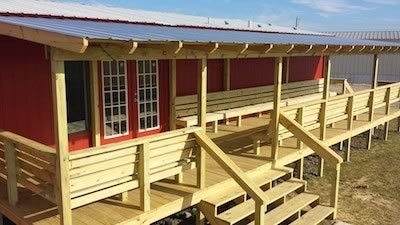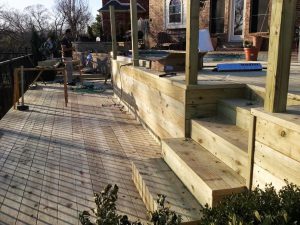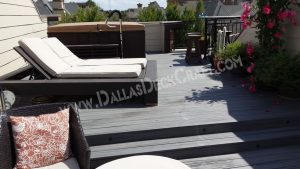Archive Monthly Archives: November 2020

Decking: Pressure-Treated Pine vs. Composite

There’s no denying pressure-treated pine is a popular decking material. It feels good under your feet, it’s a natural wood material, and it’s easy to install. Its low cost when compared to alternatives like composites is attractive to a lot of homeowners. For these reasons some people choose pressure-treated pine versus composite decking materials.
Then there’s the flipside of the coin. There are plenty of reasons to build a composite deck. PT lumber needs to be stained and sealed. You need to stain it again every 2 to 3 years. There is a good deal of annual maintenance that is not needed with composite decking materials. A composite deck can last 20 or more years, twice as long or longer than a pressure-treated deck.
Finally, composite decks hold their appearance over time. You can expect some discoloration or fading with a pressure-treated deck, especially if you fall behind on maintenance.
So, should you choose composite decking materials or pressure-treated lumber? Let’s take a deeper dive and see which makes sense for you.
What You Need to Know about Pressure-Treated Pine
The number one draw for pressure-treated pine as a decking material is low-cost. Pine trees are plentiful in North America. The largest lumber companies that harvest southern yellow pine can do so at a lower cost than woods like cedar and certainly redwood.
Pine is strong but also easy to work with. It’s not the strongest wood or the hardest by any means, but it is more than sufficient to make for a great decking material.
There is also the fact that this is real wood. It looks like wood because it is! You get a natural wood grain and feel. Build a pressure-treated deck and you are adding a slice of mother nature to your backyard.
Because this wood has to be stained and sealed, you can choose whatever color matches your home. There are literally hundreds of stain colors to choose from at your local big box store. This is another benefit of choosing pressure-treated pine over composite decking materials.
Composites definitely come in a wide variety of colors and shades. However, you may be limited to just two or three dozen choices. Head to your local big box store and ask to see the selection of stain colors for pressure-treated pine. You will see that you can choose from several hundred instead of a few dozen.
Long-Term Cost Vs. Upfront Cost
Sometimes homeowners don’t think about the long-term cost of maintaining a pressure-treated deck. After several years you may be needing to replace balusters, deck boards and other components. Even if this is not the case, there’s the cost of staining your deck every two or three years. If you don’t, then it can give into the tough Dallas weather over time.
There’s no denying your upfront cost of building a pressure-treated deck is a lot less than if you choose composite materials. Even so, a pressure-treated deck can cost more money in maintenance per year plus initial cost in its lifetime than a composite deck. If your budget doesn’t allow for the greater upfront cost of composite, then pressure-treated pine is the way to go. Remember that you will have to budget more money annually over the lifetime of a PT deck than when you maintain a composite deck.
To Clean or Not to Clean?
You should scrub your pressure-treated deck at least two or three times a year. Yes, I said scrub. This means either getting down on your hands and knees with a hand brush or using a long-handled scrub brush. You can use a retail store deck cleansing solution or just some warm, soapy water.
If you don’t like the idea of spending your free time cleaning your deck, keep this in mind. Some homeowners understand regular maintenance is a part of keeping up their home value. They don’t mind committing to the regular maintenance a pressure-treated deck requires.
How Long Can You Expect a Pressure-Treated Deck to Last?
Your PT deck should give you 8 to 12 years of functional use. This number varies according to a lot of factors, the most important factor being maintenance. I know it sounds like we are beating a dead horse here, but you have to commit to regular maintenance with a pressure-treated deck.
If not, it simply is not going to withstand what can be a difficult weather environment here in Dallas. That having been said, if you are a stickler about cleaning and maintenance as well as staining every 2 to 3 years, you could get as many as 14 or 15 years out of a pressure-treated deck.
However, any natural wood (even pressure-treated pine) can rot, splinter and warp. Staining and sealing your deck regularly can delay this natural damage but it will eventually occur. This can lead to replacement costs after your deck is several years old.
Screw Heads or No Screw Heads?
Have you ever seen a pressure-treated deck? You no doubt noticed the hundreds or thousands of screw heads. Pressure-treated lumber is so easy to work with that it just requires inexpensive screws to fasten it together. This keeps the cost down. It also means you can have a quality deck built in a few days possibly even in one day.
If you would like a pressure-treated deck with a hidden fastening system, that is sometimes possible. There are fastening systems which have been made to work with pressure-treated pine and other natural woods. However, this drives up the cost of your deck. It puts you in kind of a catch-22 situation.
If you are choosing pressure-treated pine as your decking material, you might be doing so because the low cost is so attractive. Then if you start talking about a hidden fastening system, that cost goes up. Some people don’t care that screw heads are visible throughout a pressure-treated pine deck.
A quality contractor will make sure the heads are sunk below the level of your wood and don’t cause any injury risks. However, some homeowners want a smooth and polished look. You can get that with composite decking materials. If the presence of a few screw heads doesn’t make a difference to you one way or another, this is a non-issue. If you want a clean and smooth appearance without the presence of screw heads or any other fastening system, consider composite decking materials.
The Pros and Cons of Composite Decking Materials
Cost is always a factor when a homeowner thinks about some home improvement project. It is the rare homeowner who has deep enough pockets not to be worried about how much something will cost. One of your major considerations when building a deck has to do with money.
There are upfront costs and ongoing maintenance and replacement costs. As you’ve noticed in this report, these costs can vary greatly depending on the type of decking material you choose.
Comparing Maintenance Costs
A veteran deck builder with a lot of decks under his belt can tell you the real cost of any type of decking material. In the case of pressure-treated pine vs. composite decking, there is a vast difference in maintenance and upkeep costs.
A large pressure-treated deck will set you back about $5,000 over 10 to 12 years. That’s how much you’re going to have to spend to buy sandpaper, stain and sealers, paintbrushes, scrub brushes, tarps and other necessary items and accessories. This includes having to replace physical components like decking boards and rails that have rotted, split, warp or cracked.
Your maintenance cost for the very same sized composite deck is only going to be about $500. That is a huge difference. You never have to worry about replacing spindles, boards and rails on a composite deck. This is a very real consideration as a replacement cost on a pressure-treated pine deck.
What Does Maintenance Look like with a Composite Deck?
The Fiberon composite decking company says it takes anywhere from 16 to 32 hours of maintenance on a wooden deck to keep it looking good every year. Compare that to just 2 to 4 hours per year with a composite deck.
The intensity of that annual maintenance is important to note as well. You can clean off a composite deck with a leaf blower or broom, or spray it off with a garden hose. At least two or three times a year a pressure-treated deck will require some scrubbing and elbow grease.
The construction of composite decking materials keeps them looking brand-new for 20 or 25 or more years. You have to do virtually nothing at all as far as maintenance goes. You should always remove wet leaves or natural debris from your deck as soon as it accumulates.
Aside from that, and spraying off your deck or sweeping it off, composite materials don’t really require you to do very much at all for them to look beautiful and last a long time.
Composite Decking Materials Look Great… No Screw Heads Either
Composite decking has come a long way. It used to be that the earliest composite decking boards didn’t look like wood. That is no longer the case. You can choose from dozens of colors and grain configurations that look like mother nature. The upside is that they don’t wear like mother nature. They are virtually maintenance free and can last 20 or 25 years or longer. There is also the fact that composite decking holds its appearance over time. It won’t fade or discolor like natural woods can.

Are you looking for a consistent appearance? No two natural wood boards look alike, either in color or grain pattern. You can get a pleasing and consistent look with composite decking materials. The grain configurations and colors of the boards are the same from one board to the next.
By the way, you don’t have to worry about staring at screw heads. There are hidden fastening systems made for composite decking materials so you get a clean and smooth, fastener-free appearance. This also means you won’t have any screw heads working their way above the surface of the wood and causing a safety risk like you can have happen with a pressure-treated pine deck.
Pressure-Treated Pine vs. Composite Decking Materials – The Wrap-Up
Are you building a deck on a tight budget? Pressure-treated pine might be the way you need to go. It definitely costs a lot less upfront than if you were to build a deck with composite materials. Just remember that it’s easy to promise you are going to do all the maintenance that is required to keep a PT deck looking good.
It might be a different story when those maintenance tasks roll around.
That’s the beauty of a composite deck. You don’t really have to do anything other than brush it off and hose it down every now and then. Composite materials keep their appearance for 20 or more years. A pressure-treated deck can look great for its 10 to 12 year lifetime, it just requires a little more elbow grease than a composite deck does.
You are definitely going to have to pay more to build a deck with composite materials on the front end. However, maintenance and replacement costs are next to nothing every year when compared to what you have to do to keep a pressure-treated deck functional and good looking. There are a lot of benefits to either choice.
Whether you choose composite decking materials or pressure-treated lumber, you get to create great memories with your friends and family. You get out of the house and into the beautiful weather Dallas has to offer. Either type of deck provides you with a refuge after a long, hard work week or at the end of the day.
Give us a call and get your questions answered. We will give you unbiased information regarding pressure-treated lumber and composite decking materials. As we just discussed, there are pros and cons of both types of decks. Set up a time when we can come to your home and give you a free estimate. We’ll take a look at your particular situation and have a conversation about what you expect from your deck. That can help you decide what material you’re going to choose and we can get started building the outdoor deck of your dreams.
